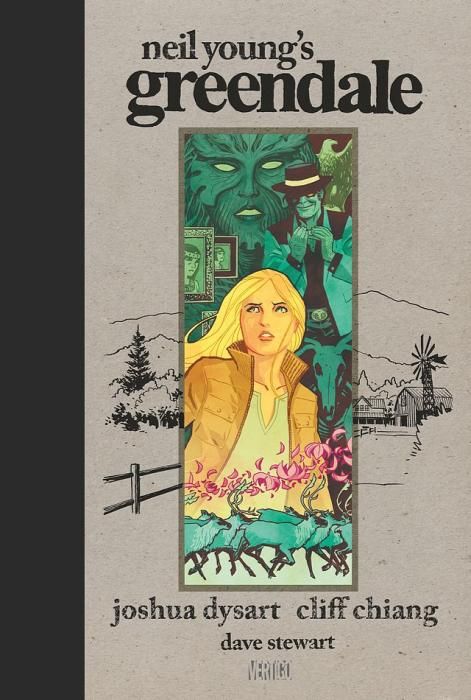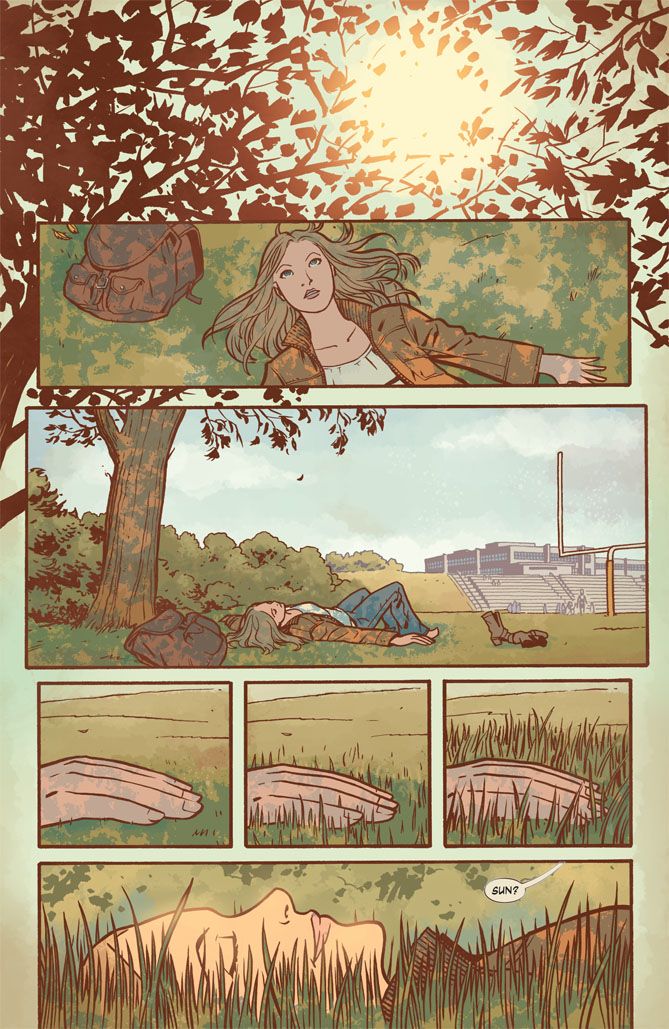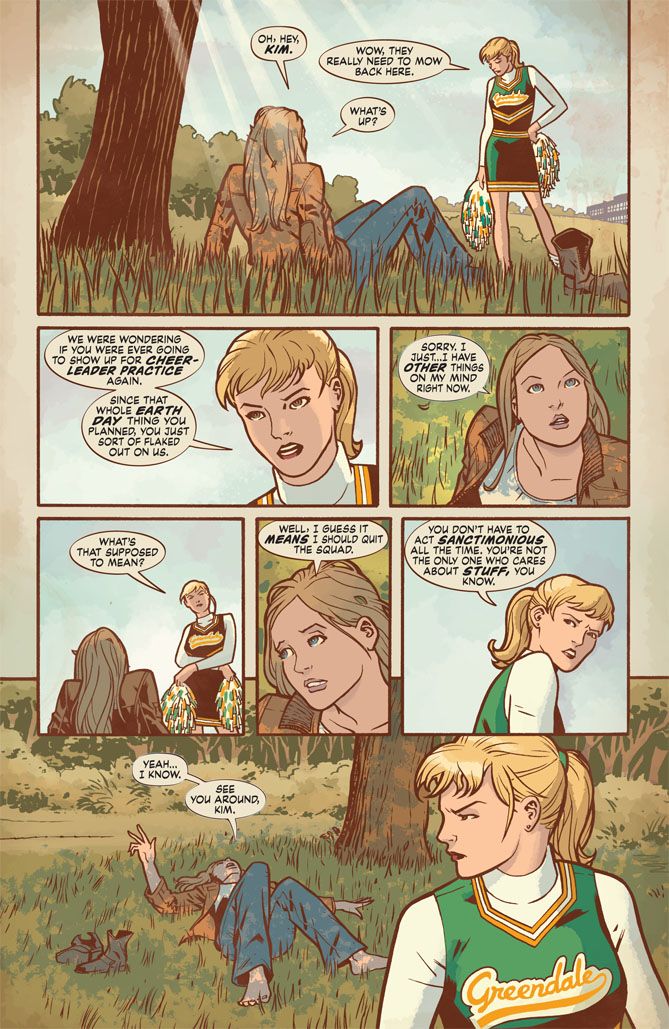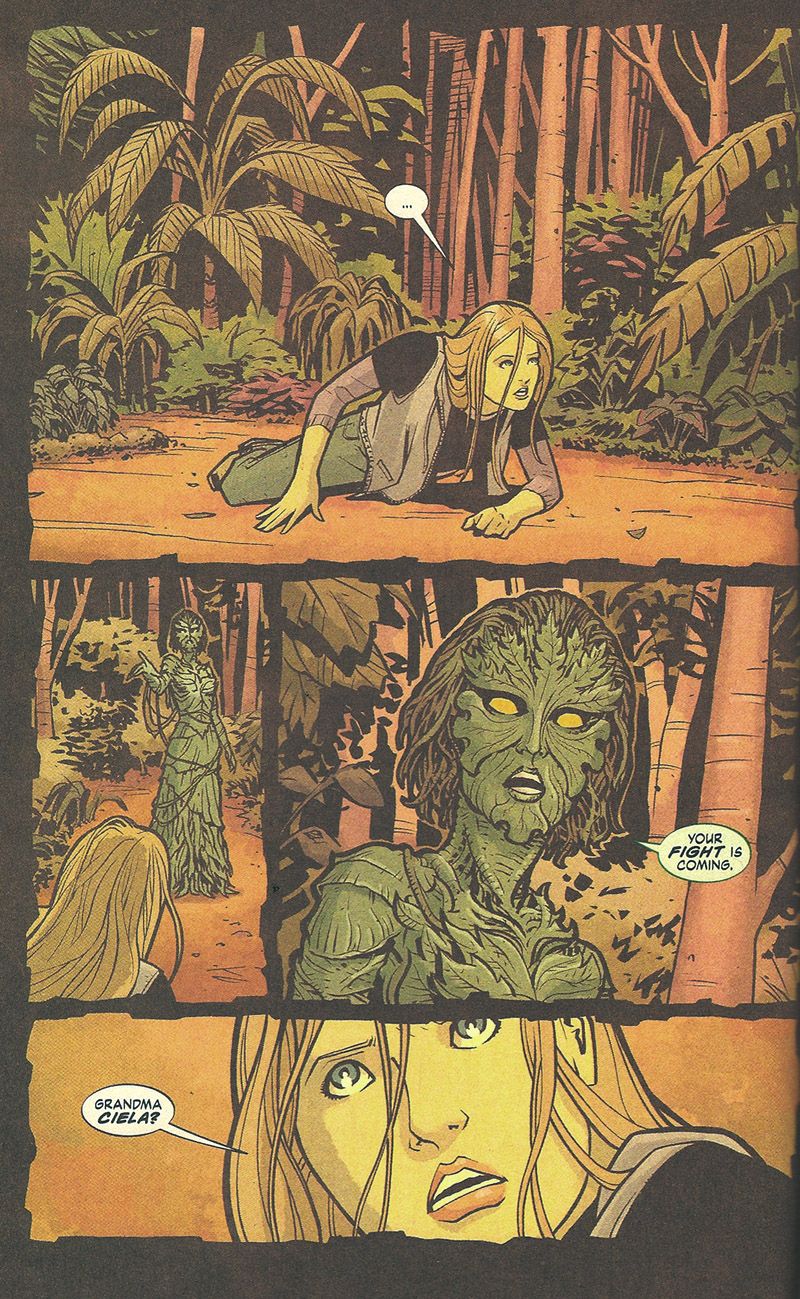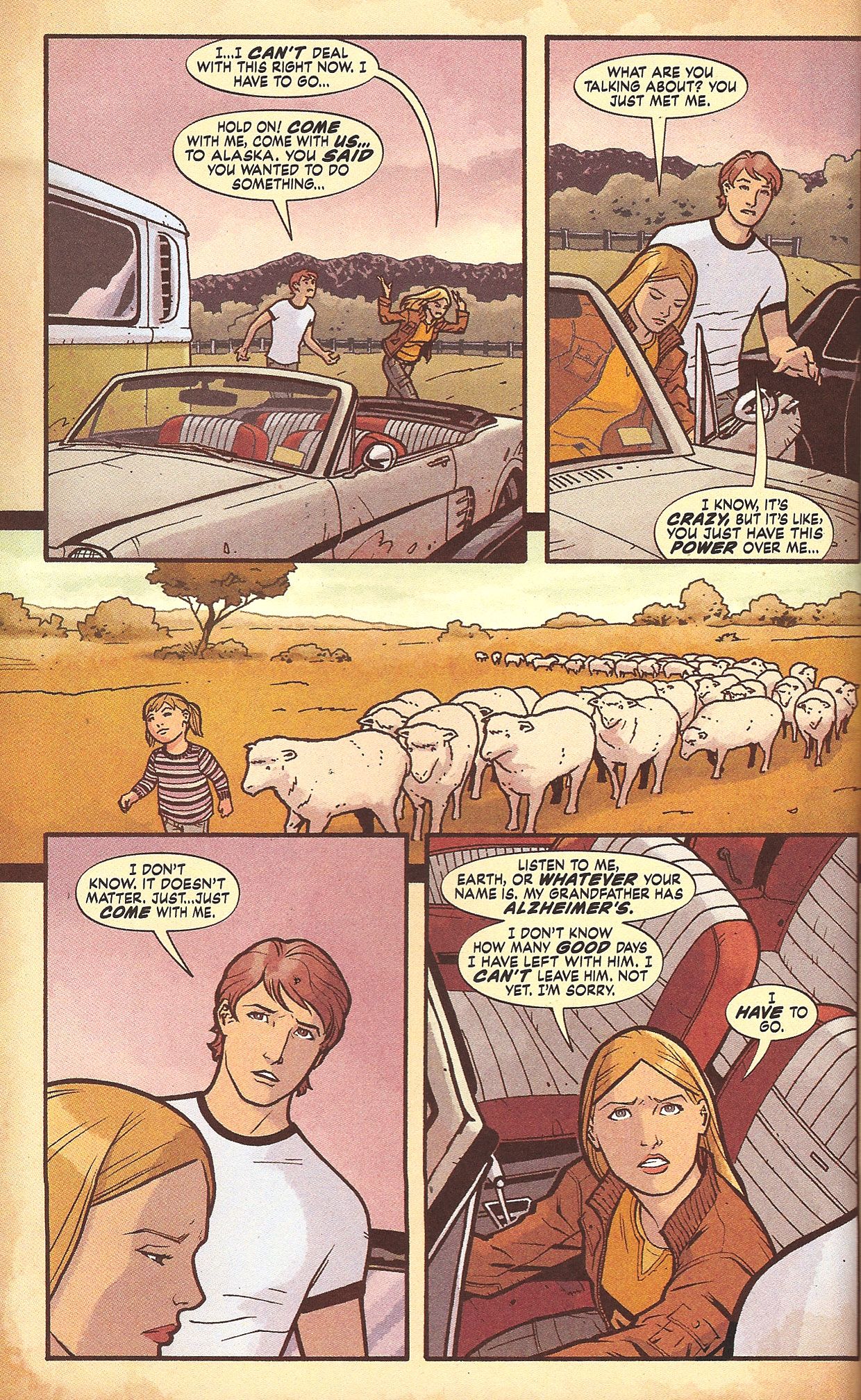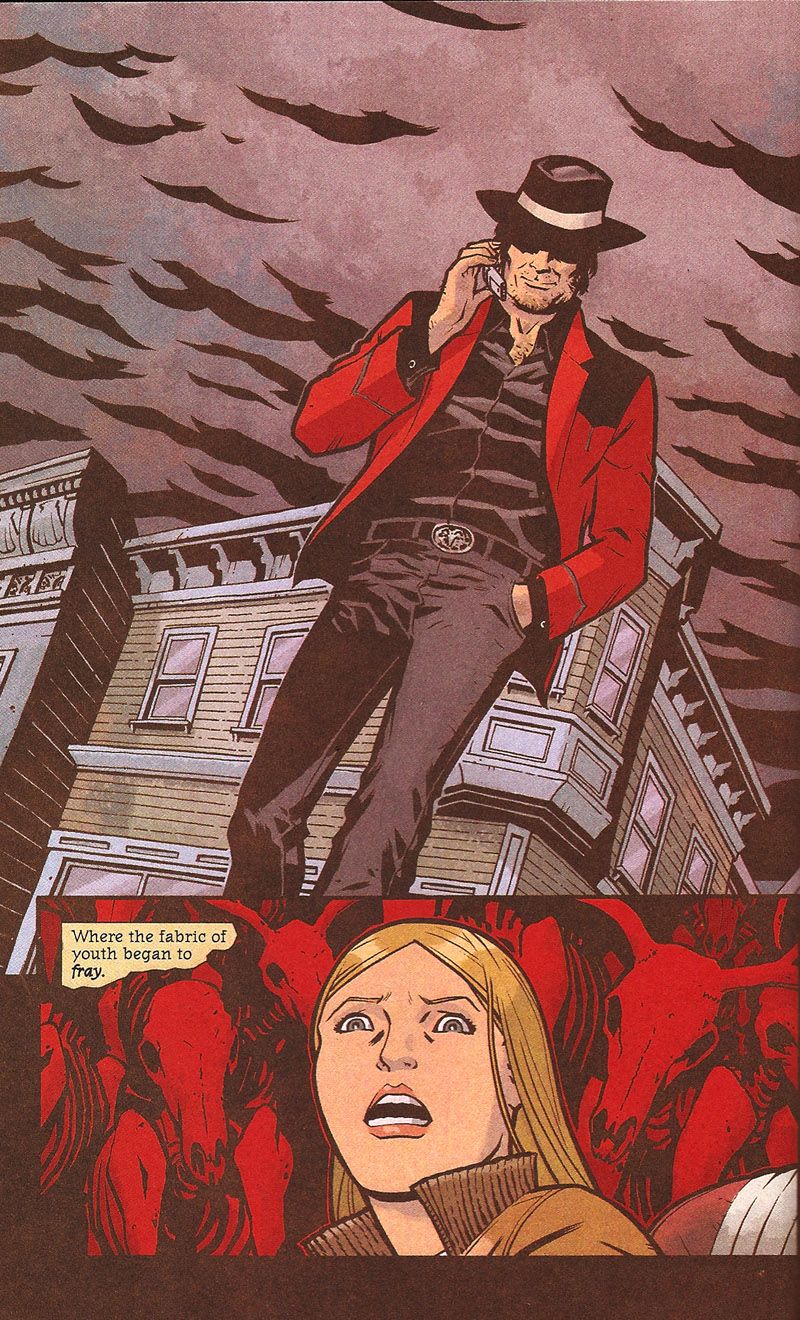Neil Young’s Greendale. Joshua Dysart (writer). Cliff Chiang (art). Dave Stewart (colors).
Todd Klein (letters). Karen Berger (editor). Vertigo. 160 pages. Color. Hardcover. $19.99
I’ve mentioned my as yet unpublished novel a few times before in this column because it happened to relate cursorily to whatever I was talking about that week. But there’s nothing cursory about how Joshua Dysart’s adaptation of Neil Young’s Greendale relates to my novel.
Fortunately (and with a huge sigh of relief) plot-wise they are in no way similar, however what Dysart has created in his adaption is exactly the type of powerful female myth, legend, and feminist modern fairy tale that I hoped to create in my own book. When I looked to superheroes (and make no mistake, despite the lack of colorful pajamas, Sun is a superhero) I found a real lack in strong female characters set up the way Sun is set up here – as the uncontested powerful star with a history of powerful female ancestors and an epic destiny set before her. It was a lack of truly great stories like that for women that inspired me to try it myself, and I am really excited to see one here, so beautifully executed by Young, Dysart, Chiang, and Stewart.
Greendale is the story of Sun Green, a teenager coming of age in Greendale, California and set against a timely landscape of political unrest, war, and environmental crisis. Sun, guided by tragedy, ancestral gifts and instinct, and some seriously intense prophetic dreams, is trying to find her way and purpose in life which includes embracing her ancestry, finding love, trusting herself, and rising up to take a stand, but at it's core it's simply the well-worn tale of discovering yourself, and perhaps more importantly accepting yourself.
Everything here is interesting. The environmental crisis, which though a bit dated since it’s so specific, still feels wholly relevant to what is going on in the United States yesterday, today, and I’m sure, tomorrow. The set up of Sun as a “special” girl essentially since birth is built into the story from literally panel one and creates a great tapestry of the history and future of the Greens. Every aspect of this story is well-explored and expertly layered, subtly laying down all the necessary elements one by one as Dysart raises the stakes page by page.
The entire piece is engaging and well done, but as a feminist I was most impressed with the fact that the basic mythology of the Greens (and Oaks to a lesser degree) sets up the female characters as the power houses and the males, while still great characters, act more as the important but vulnerable aspects of these womens' lives. There was nothing anti-male in the book at all (it’s a sad but all too common misconception that something with a feminist slant or a strong female perspective is somehow anti-male) it’s simply a graphic novel that happens to star powerful women that have fathers, brothers, grandfathers, friends, and boyfriends that they love, but that are not the center of the story, instead allowing the women to be the source of power and the cogs upon which the story turns. Honestly? It was nice to see. It doesn't mean I don't love stories that star men...it just means that it's nice to see a brilliant work that stars women sometimes too.
I wonder if Dysart realized that he was creating such a significant feminist work. I know if I had been collaborating with Neil Young on adapting a work he was so invested in it would have been the thing farthest from my mind (read: I would have been worrying myself into an early grave). And yet what has emerged is a significant and decidedly feminist work that really helps broaden the field of great female focused graphic novels available today.
So should we talk about the art and the fact that it is mind-blowingly beautiful? Yeah, let’s talk about that. Cliff Chiang’s pencils are nothing short of stunning. He’s created such a cohesive and fully realized world for Sun that you doubt nothing. Everything is executed with precision and grace, feeling both loose and expressive and crisp and clean simultaneously. Chiang’s storytelling is always both clear and beautiful, somehow never having to sacrifice one for the other, as many artists do, and Greendale is no exception. He illustrates Sun’s every day life, the history of the Green’s, and Sun’s vivid and prophetic dreams all with the same attention to detail and dedication to good storytelling.
It’s also important to note that without Chiang’s equally as female positive art, much of what lands this solidly as a feminist work would have been lost. A Sun with 36 double d’s falling out of her tank top and mini-skirt are visuals that certainly would have undone or at least severely undercut the vision that Dysart (and Young) were aiming for. And it's a great example of why character design is so important and why here it's a perfect fit. The Sun Dysart is writing, looks exactly like the Sun Chiang is drawing, and vice versa. Chiang’s work, as always in my experience, is so in touch with the tone of the story he’s bringing to life, that it's nearly a seamless collaboration...a nearly perfect merging of word and picture...as if Dysart and Chiang were one.
The colors, by Dave Stewart are sublime in their execution. Everything slightly soft and faded, except for the occasional well considered hard blacks and reds. It’s all wonderfully constructed and it’s somehow considered to the point of obsession while still feeling natural and easy.
Visually there’s very little hard black and white in this book, trending more toward softer earth tones, which fits both tonally and thematically and suggests a real care of construction. The kind of care you usually get (and expect) from single creators (David Mazzucchelli’s Asterios Polyp springs to mind as a good recent example) but rather than a sole creator working towards their own personal vision, you have here what feels like a finely tuned orchestra all working together to achieve perfection.
And they get shockingly close.
The edition itself is lovely and really lives up to the talent and themes of the book. The gorgeous embossed cover sans dust jacket (a personal favorite of mine stylistically) really stands out and elevates the book beyond your average graphic novel. The end papers are beautiful Chiang illustrated family trees and maps of Greendale. The actual paper is a matte finish that almost has a tooth to it and that carries Stewart’s colors perfectly. Also appropriately, the book is stamped ‘sustainable forestry initiative’. My sole complaint about the edition is that the gutters at the binding are almost non-existent, causing some images to get slightly lost in the crease (and also making it a real bitch to scan). But otherwise it’s stunning - something that can sit proudly on your shelves for years to come.
I think Dysart and Chiang have created a work that can easily stand on its own without foreknowledge of everything Greendale. Personally, I’m familiar with the album (but not obsessively so) but haven’t seen the film, art books, theater productions, or website, etc., and so I come to it somewhat in the know, but far shy of those who are experts in all things Greendale. With my limited experience the book easily stands on its own for me, yet it still feels respectful of the source material – I have trouble imagining a Greendale purist taking issue with such a beautiful, well-executed book. It’s no easy task to straddle those two extremes (uber fan and virgin) but Dysart and Chiang do it and make it appear effortless.
Neil Young's Greendale released on June 15th, 2010 and is available in book shops and comic stores everywhere and online at Amazon.


